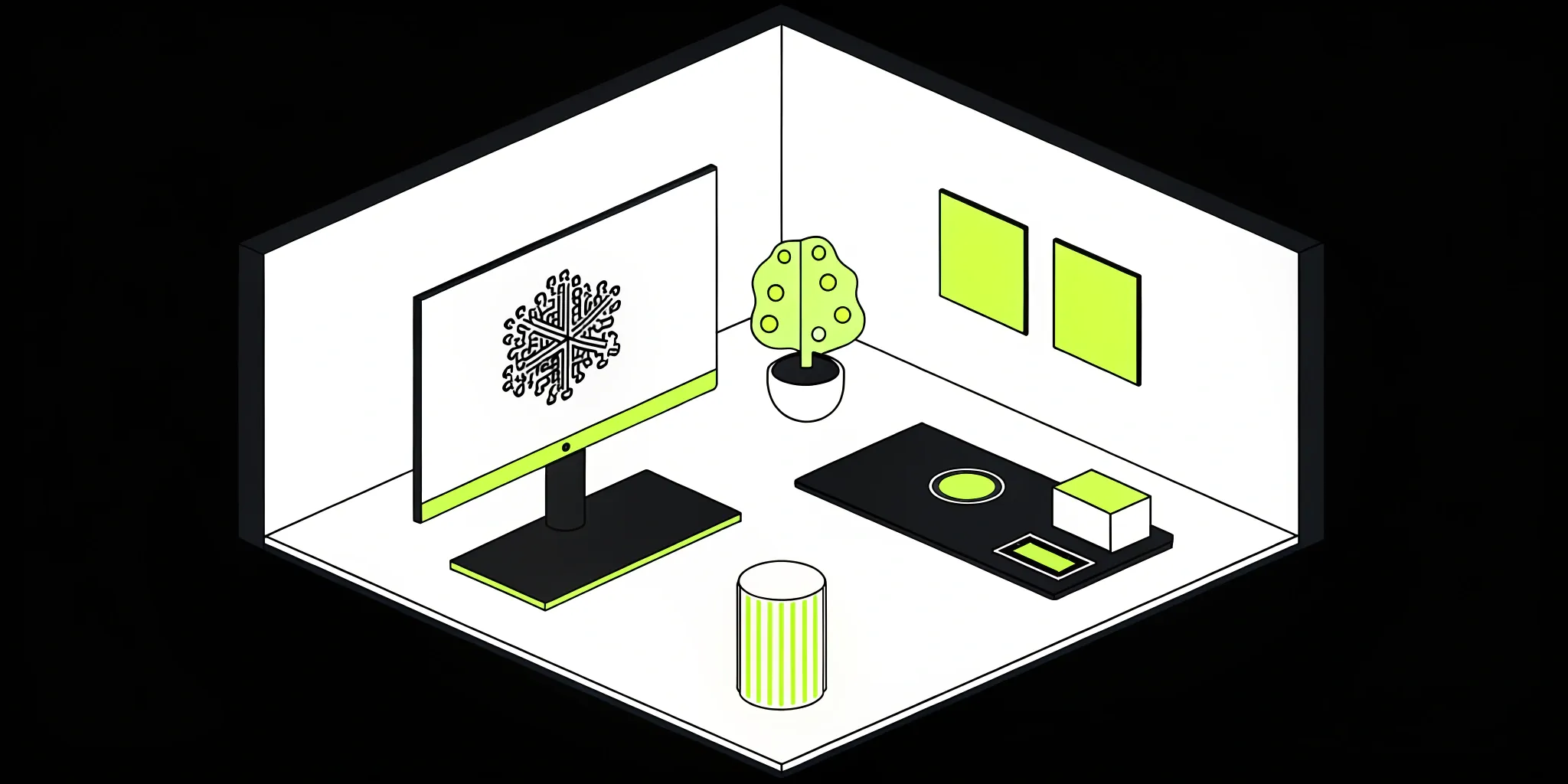How to Build a Custom AI Solution for Healthcare

You see the potential for AI in your organization, but the path from a great idea to a working tool can feel overwhelming. Building a custom AI solution is a major project, but it becomes much more manageable when you break it down into clear, actionable steps. This guide is designed to give you that clarity. We'll show you how to build a custom AI solution for healthcare by focusing on the fundamentals: pinpointing a specific problem, gathering high-quality data, and assembling the right cross-functional team. Let's get started on creating a powerful tool that makes a real impact on patient outcomes and operational efficiency.
Key Takeaways
- Define your problem before you touch any technology: The most successful AI projects solve a specific, real-world challenge. Get clear on the exact problem you want to fix for your clinicians or patients before you consider which tools to use.
- Data quality and compliance are non-negotiable: Your AI solution will only be as trustworthy as the data it’s trained on. Prioritize gathering high-quality, representative data and build your entire process around strict compliance with regulations like HIPAA to protect patient privacy.
- Plan for the entire lifecycle, not just the launch: Building a great AI tool is a team sport that requires ongoing effort. Assemble a cross-functional team and plan for continuous monitoring, testing, and refinement to ensure your solution remains accurate, fair, and effective long-term.
Why does healthcare need custom AI?
Healthcare organizations are under constant pressure, juggling growing patient loads, complex administrative tasks, and a flood of data. While general AI tools are becoming more common, healthcare has unique, high-stakes needs that a one-size-fits-all solution often can't meet. Your workflows, patient data, and compliance requirements are specific to your organization, and your technology should be too. This is where a custom approach makes a significant difference.
Instead of trying to fit a square peg into a round hole, a custom AI solution is built from the ground up to address your specific challenges. Imagine an AI agent designed to perfectly integrate with your existing electronic health record (EHR) system to streamline patient intake or one that automates billing codes based on your clinic’s specific services. By tailoring the technology to your team's daily reality, you can reduce the administrative burden and free up your skilled professionals to focus on what they do best: providing excellent patient care.
Ultimately, the goal is to improve patient outcomes. Custom AI can help you get there by enhancing diagnostic accuracy, personalizing treatment plans, and making your operations more efficient. While building a custom AI solution is a complex process that requires careful planning and the right expertise, the investment pays off. You get a tool that works for you, not the other way around, creating a more effective and sustainable system for both your staff and the patients you serve.
Before you write a single line of code or even think about what technology to use, you need to get crystal clear on what you're trying to accomplish. This might sound obvious, but it’s the step where many ambitious AI projects go wrong.
Define your project goals and objectives
Before you write a single line of code or even think about what technology to use, you need to get crystal clear on what you're trying to accomplish. This might sound obvious, but it’s the step where many ambitious AI projects go wrong. They start with a cool technology instead of a concrete problem. Building an effective AI solution begins with a deep understanding of the challenge you want to solve, because many AI projects fail when they don't align with real-world needs.
So, what does this look like in practice? It means sitting down with your team and defining the specific, measurable goals for your AI. Think less about "building an AI" and more about "solving a problem." Focus on tasks that are currently difficult, time-consuming, or require significant human effort. For example, are you trying to reduce the time clinicians spend on administrative paperwork? Or maybe you want to help radiologists detect anomalies in medical scans more quickly.
To get to the heart of your project, ask these key questions:
- What specific job will the AI perform? Will it summarize patient notes, answer billing questions, or predict patient readmission risks?
- What information will it need? Will it process text from electronic health records, analyze images like X-rays, or use numerical data from lab results?
- How will we know it’s working? What are the key performance indicators (KPIs)? This could be anything from a 20% reduction in administrative tasks to a 15% improvement in diagnostic accuracy.
Clearly defining these objectives is the foundation of your entire project. It sets the direction for everything that follows, from the data you'll need to gather to the AI technologies you'll ultimately choose. With a solid plan in place, you can move forward confidently, knowing that you're building a solution that will make a tangible difference in your healthcare setting.
How to develop your healthcare AI solution
Building a custom AI solution can feel like a massive undertaking, but it becomes much more manageable when you break it down into a clear, step-by-step process. A structured approach helps you stay focused on the end goal and avoid common pitfalls, like building a solution that doesn’t solve a real-world problem. Think of this as your roadmap from initial idea to a functional, effective tool that can make a real difference for clinicians and patients.
Each stage builds on the last, creating a strong foundation for a successful project. It all starts with a deep understanding of the problem you want to solve and the data you have to work with. From there, you move into the more technical phases of choosing your tools, training your model, and testing its performance. While the technical details can get complex, having a partner or a comprehensive platform can streamline the entire journey. A managed solution like Cake handles the underlying infrastructure and provides production-ready components, letting your team focus on the development steps that matter most.
1. Pinpoint the problem you want to solve
Before you write a single line of code, you need to know exactly what you’re trying to achieve. An effective AI solution starts with a clearly defined problem, not a piece of technology. Many AI projects stumble because they are disconnected from the actual needs of the people they’re meant to help. Talk to clinicians, administrators, and even patients to understand their biggest pain points. Are you trying to reduce diagnostic errors, automate tedious administrative tasks, or predict patient readmission rates? Get specific. A focused goal, like "reducing appointment no-shows by 15%," is much more actionable than a vague one like "improving efficiency." This initial problem discovery phase is your most important one.
2. Gather and prepare high-quality data
High-quality data is the lifeblood of any AI model. Your solution will only be as good as the data you train it on. This stage involves gathering all the relevant information you need and then getting it ready for the model. Data preparation isn't glamorous, but it's essential. It involves cleaning the data to remove errors, fill in missing values, and get rid of duplicate entries. You’ll also need to normalize it, which means structuring everything in a consistent format so the AI can process it effectively. Rushing this step is a recipe for an inaccurate and unreliable model, so invest the time to get your data quality right from the start.
3. Choose the right AI technologies
With a clear problem and clean data, you can start thinking about the tools you’ll use to build your solution. The AI landscape is full of powerful open-source frameworks and libraries, and your choice will depend on the complexity of your project and the specific task at hand. Popular options include TensorFlow for large-scale models, PyTorch for its flexibility in research, and Scikit-learn for more traditional machine learning tasks. You don't need to be an expert in all of them, but it's important to select a technology stack that fits your team's skills and your project's goals. This is another area where a managed platform can help by providing pre-vetted, integrated tools that are ready for production.
4. Develop and train your AI model
This is where the magic happens. Training is the process of "teaching" your AI model to recognize patterns and make decisions based on the data you’ve prepared. You feed your cleaned data into the model, and it adjusts its internal parameters over and over again to improve its predictions and minimize errors. It’s an iterative process of feeding it information, letting it make a guess, correcting it, and repeating until its performance is strong. This phase requires significant computational power and expertise to fine-tune the model for the best results. The goal is to create a model that can generalize what it has learned to make accurate predictions on new, unseen data.
5. Test, validate, and iterate
Once your model is trained, you need to see how well it performs in the real world. This means testing it on a fresh set of data it has never seen before. This step is crucial for ensuring your model is not just memorizing the training data but has actually learned the underlying patterns. You’ll measure its performance using key metrics like accuracy to see how often it gets things right. But testing isn't a one-time event. It’s a continuous cycle. Based on the results, you’ll likely go back to refine your data, adjust your model, and retrain it. This iterative loop of model validation and improvement is what leads to a robust, reliable, and truly helpful healthcare AI solution.
You’re dealing with protected health information (PHI), which means every step of your data handling process is under a microscope. Getting this right isn’t just about building an effective model; it’s about protecting patients, maintaining trust, and meeting strict legal requirements.
What to know about handling healthcare data
Data is the engine of any AI solution, but in healthcare, it’s also incredibly sensitive. You’re dealing with protected health information (PHI), which means every step of your data handling process is under a microscope. Getting this right isn’t just about building an effective model; it’s about protecting patients, maintaining trust, and meeting strict legal requirements. A single misstep can have serious consequences for both your project and the people it’s meant to serve.
Before you write a single line of code, you need a solid strategy for your data. This involves more than just finding a dataset. You need to think through what kind of data you need, how you’ll ensure its quality and privacy, and what security measures you’ll put in place to protect it. Building a robust data management plan from the outset will save you from major compliance headaches and technical debt down the road. It’s the foundation upon which your entire AI solution rests. While a platform like Cake can manage the complex infrastructure for you, your team is still responsible for the data itself.
What kind of data do you need?
Your AI model is a direct reflection of the data it learns from. That’s why gathering high-quality, accurate information is the most critical step in the entire process. If you feed your model incomplete or irrelevant data, you’ll get unreliable results. For a healthcare application, that’s a risk you can’t afford to take. Focus on sourcing data that is clean, well-structured, and directly related to the problem you’re trying to solve. This could include electronic health records (EHRs), medical imaging files, or genomic data. The data preparation phase—cleaning, labeling, and organizing—is often intensive, but it’s an investment that pays off in model accuracy and reliability.
Keep your data high-quality, compliant, and private
In healthcare, poor data quality can lead to incorrect predictions and flawed medical decisions. Beyond quality, you have a legal and ethical duty to protect patient privacy. This means your project must adhere to strict regulations. In the United States, the primary regulation is the Health Insurance Portability and Accountability Act (HIPAA), while Europe follows the General Data Protection Regulation (GDPR). Following these rules isn’t just about checking a box; it’s a fundamental requirement for operating in the healthcare space. Building compliance into your workflow from the start is essential for protecting patient data, avoiding steep fines, and establishing your solution as trustworthy and credible.
Create a plan for data management and security
A strong security framework is non-negotiable. Your data management plan should outline exactly how you’ll protect sensitive information at every stage. Start by ensuring all data is encrypted, both when it’s stored (at rest) and when it’s being transmitted (in transit). Implement strict access controls so that only authorized individuals can access patient data, and use detailed logs to track every action taken. Security isn’t a one-time setup, either. You need to continuously monitor your systems and maintain your AI model to ensure it remains secure and effective long after deployment. This ongoing vigilance is key to long-term success.
Select the right tools and technologies
Once you have your data and your model in mind, it’s time to choose your toolkit. Selecting the right technology is about more than just picking the flashiest new platform; it’s about building a sustainable, secure, and effective solution. Your tech stack will be the foundation of your AI project, influencing everything from development speed to long-term maintenance.
This decision has two main parts. First, you’ll need to select the AI frameworks and platforms that are best suited for your specific healthcare application. Second, you have to create a solid plan for how this new solution will integrate with the complex web of systems already running in your healthcare environment. Getting this right is critical, and it’s where having a partner that manages the entire stack can make a huge difference. By handling the infrastructure and integrations, a comprehensive platform like Cake lets your team focus on what they do best: solving healthcare challenges.
Find the best AI platforms and frameworks
The AI landscape is full of powerful tools, and your job is to find the one that fits your project’s purpose and complexity. You don’t need the most complicated tool if a simpler one will get the job done right. For many custom builds, developers turn to popular open-source libraries like PyTorch or TensorFlow. These frameworks provide the flexibility to build and train models from the ground up.
You can also look at platforms designed for certain tasks. For example, you might use a specialized tool like Microsoft Azure Health Bot for conversational AI or a more general platform like Google Vertex AI for a wider range of machine learning projects. The key is to match the tool to the task. There isn't a single "best" platform for every situation, so focus on what your solution needs to accomplish and choose the technology that gives you the clearest path to success.
Plan for integration with existing systems
Your AI solution can’t operate in a silo. To be truly effective, it needs to communicate seamlessly with the systems your organization relies on every day, especially Electronic Health Records (EHRs). This is where a thoughtful integration plan becomes essential. Without it, your powerful new tool might end up being a clunky, standalone application that creates more work than it saves.
The key to smooth integration is interoperability. You’ll need to use established healthcare data standards, like FHIR (Fast Healthcare Interoperability Resources), to ensure your AI can securely access and exchange information with your EHR and other clinical systems. This connection needs to be built with security, privacy, and scalability in mind from the very beginning. Planning for this early ensures your AI solution can deliver real-time insights and automate tasks right where your team needs them most.
Build your cross-functional AI team
Building a successful healthcare AI solution is a team sport, not a solo mission for your tech department. The complexity of healthcare means you need more than just brilliant coders; you need a group of experts who can bridge the gap between technology and real-world clinical practice. Think of it less like hiring a single developer and more like assembling a specialized medical team where every member brings a unique and critical perspective to the table. Your project's success depends on this blend of technical skill and deep industry knowledge.
A truly effective team brings together diverse expertise. On one side, you have your technical powerhouses: data scientists, AI and machine learning engineers, and software developers who can build and train the models. On the other, you have your indispensable domain experts: the doctors, nurses, and administrators who understand patient workflows, clinical needs, and the nuances of healthcare delivery. This effective collaboration is non-negotiable. Your clinicians are the ones who can validate whether your solution actually solves a real problem for them and their patients, not just a theoretical one.
As you assemble your roster, remember to include people with a firm grasp of healthcare regulations. Their guidance will be essential for keeping your project compliant and ethically sound. You can build this team by hiring new talent with specific experience or by investing in training for your existing staff who already know your organization's culture and goals. By bringing together the right people, you create an environment where technical innovation is guided by practical, clinical wisdom, ensuring the solution you build is not only powerful but also genuinely useful and safe.
How to handle compliance and ethics
When you’re building a tool that can impact someone’s health, getting the ethics and compliance right isn’t just a feature—it’s the foundation of your entire project. While a platform like Cake can manage the technical stack and accelerate your build, your team is ultimately responsible for creating a solution that is safe, fair, and trustworthy. This means going beyond the code to address the human side of AI.
Successfully handling these responsibilities comes down to three key areas. First, you need a deep understanding of the legal landscape, including the major regulations that govern patient data. Second, you must commit to ethical principles that ensure your AI is transparent and accountable. Finally, you have to actively work to identify and eliminate bias from your models to ensure equitable care for everyone. Tackling these challenges head-on is the only way to build a solution that clinicians will trust and patients will benefit from.
Understand key regulations like HIPAA and GDPR
Following rules like HIPAA and GDPR is non-negotiable. These regulations are designed to protect sensitive patient information, and compliance is essential for avoiding serious legal trouble and financial penalties. More importantly, adhering to these standards is how you build fundamental trust with both patients and providers.
Think of these regulations not as a restrictive checklist, but as a framework for responsible innovation. They guide you in setting up secure data handling practices and ensuring patient privacy is respected at every step. Your approach to HIPAA and other regulations will define your reputation and the long-term viability of your solution.
Put ethical AI principles into practice
AI decisions in healthcare can’t be a “black box.” For a clinician to trust and act on a recommendation from your AI, they need to understand how the model arrived at its conclusion. This is the core idea behind transparent and explainable AI. It’s not enough for the tool to be accurate; it must also be interpretable, especially when a decision could have significant consequences for a patient’s care.
Putting ethical principles into practice means designing your system for accountability. Who is responsible if the AI makes a mistake? How can a clinician override a recommendation if their expertise suggests a different path? Building a trustworthy AI solution requires clear answers to these questions and a commitment to an AI Risk Management Framework that prioritizes patient safety and clinical judgment.
How to reduce bias in your AI models
An AI model is only as good as the data it’s trained on. If your training data is skewed, your model will be, too. For example, if an AI learns to identify a disease primarily from data from one demographic, it may be less accurate for others, leading to disparities in care. This is a critical risk, as algorithmic bias in health care can perpetuate and even amplify existing inequities.
To reduce bias, you must be intentional about sourcing diverse and representative datasets. Your work doesn’t stop once the model is built. You need to continuously test your AI for fairness across different patient populations, checking for any performance gaps. Regularly auditing your models for bias and refining them with more inclusive data is an ongoing process that is essential for creating a truly equitable healthcare solution.
Overcome common development challenges
Even the most well-planned AI project will run into a few challenges. Thinking about these potential hurdles ahead of time is the best way to keep your project on track. While every project is unique, two of the most common issues that pop up during healthcare AI development are getting new tools to work with existing systems and, just as importantly, getting people to embrace and use the new solution. Addressing these technical and human factors from the start will make the entire process smoother and set your solution up for success.
Solve for system interoperability
One of the biggest technical hurdles is interoperability—making sure your custom AI solution can communicate effectively with the systems a hospital or clinic already relies on. You aren't building in a vacuum; your tool needs to connect smoothly with existing software, especially Electronic Health Records (EHRs). This is where a custom approach really shines, as it can be built specifically for your organization's needs. To make this connection happen, your development team will likely use established healthcare data standards. A key one to know is FHIR (Fast Healthcare Interoperability Resources), which provides a common language for different health tech systems to exchange information securely and efficiently.
Encourage user adoption and manage change
A brilliant AI tool is only useful if people actually use it. Many AI projects fail not because the technology is flawed, but because they don't solve a real-world problem for the end-users. The best way to avoid this is to talk to everyone who will be affected—doctors, nurses, administrators, and even patients—before you write a single line of code. This user-centered design approach builds trust from day one. When designing the AI itself, focus on clear, empathetic communication. In healthcare, a calm and reassuring tone is far more effective than overly casual language.
Set your AI solution up for long-term success
Getting your AI solution up and running is a huge milestone, but the work doesn’t stop at launch. Think of it like a garden; it needs continuous care to thrive. The most successful AI initiatives are the ones that are actively monitored, measured, and improved over time. This ongoing process ensures your solution remains accurate, effective, and continues to deliver real value to your healthcare organization. Focusing on these final steps is what separates a short-term project from a long-term strategic asset. It’s all about creating a cycle of feedback and refinement that keeps your AI performing at its best.
Monitor and improve your solution continuously
Your AI model isn't static. Over time, its performance can decline in a process known as "model drift." This happens because the real-world data it encounters starts to differ from the data it was trained on. To prevent this, you need a plan for maintaining your AI solution from day one. This involves regularly tracking its performance metrics, retraining it with fresh data, and addressing any issues that pop up. Being proactive here is key. By setting up a consistent monitoring and maintenance schedule, you ensure your AI remains a reliable and effective tool for your team, adapting as healthcare data and practices evolve.
Measure your impact and adapt as you go
How do you know if your AI is truly making a difference? You have to measure its performance and impact. Start by testing how well the model performs on new data it has never seen before, looking at metrics like accuracy and precision. It's also critical to check for any unintended bias to ensure fair outcomes for all patient groups. If the performance isn't quite right, don't worry—that's a normal part of the process. You can fine-tune the model by adjusting its settings or training it with more data. Creating a feedback loop to make improvements based on input from clinicians and patients is also incredibly valuable for guiding your adjustments.
Related Articles
- Agentic AI: The Future is Autonomous & Smart
- Key Applications of Artificial Intelligence Today
- Healthcare, Powered by Cake
- Top 14 Healthcare AI Use Cases
- 9 Best Data Ingestion Tools: A Deep Dive Review
Frequently asked questions
Why can't I just use a general, off-the-shelf AI tool for my clinic?
While general AI tools are powerful, they aren't designed for the specific, high-stakes environment of healthcare. Your clinic has unique workflows, patient data requirements, and compliance needs that a one-size-fits-all solution can't address. A custom solution is built to integrate perfectly with your existing systems, like your EHR, and is tailored to solve the specific problems your staff faces every day, leading to better adoption and more meaningful results.
This sounds very technical. What's the most important non-technical step my team should focus on?
Before you even think about technology, the most critical step is to clearly define the problem you want to solve. This involves talking to the people who will actually use the tool—your clinicians, nurses, and administrators. By understanding their biggest challenges and daily frustrations, you can set a specific, measurable goal. Focusing on a real-world need ensures you build a solution that people will actually want to use.
My team is great with technology, but we're worried about the healthcare regulations. How do we start?
Navigating regulations like HIPAA is a valid concern, and it's a non-negotiable part of the process. The best way to start is by making compliance a core part of your project plan from day one, not an afterthought. This means building a team that includes someone with regulatory expertise and designing your data management plan around security principles like encryption and strict access controls. Think of these rules as a framework for building trust, not just a hurdle to clear.
Our biggest challenge is getting new software to work with our existing EHR system. How does a custom AI solution handle that?
This is a common and significant challenge, and it's one of the main reasons a custom approach is so effective. A custom AI solution is designed from the start with your specific systems in mind. It uses established healthcare data standards, like FHIR, to create a secure and reliable bridge to your EHR. This ensures the AI can access the information it needs and deliver insights directly into your team's existing workflow, rather than forcing them to use a separate, disconnected application.
Once our AI solution is built and launched, is the project finished?
Launching your AI is a major accomplishment, but the work isn't over. An AI model needs ongoing attention to remain effective. You'll need to continuously monitor its performance to ensure its accuracy doesn't degrade over time, a process known as model drift. This involves regularly retraining the model with new data and making adjustments based on feedback from users. This cycle of monitoring and improvement is what turns a good AI tool into a lasting strategic asset for your organization.
About Author

Cake Team
More articles from Cake Team
Related Post

Building AI-Powered SaaS: Overcoming Common Challenges

Cake Team

AI-Powered Healthcare Solutions: Common Challenges

Cake Team

How to Build a DIY AI Insurance Solution: A Step-by-Step Guide

Cake Team

AI in Insurance: Solving the Biggest Challenges

Cake Team